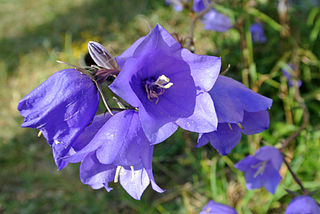
Campanula is the type genus of the Campanulaceae family of flowering plants. Campanula are commonly known as bellflowers and take both their common and scientific names from the bell-shaped flowers — campanula is Latin for "little bell".

Adenophora is a genus of flowering plants in the family Campanulaceae, the bellflowers. Plants of this genus are known commonly as ladybells. Most are native to eastern Asia, with a few in Europe. Many are endemic to either China or Siberia.

Pinus bungeana, also known by the common names Bunge's pine, lacebark pine and white-barked pine, is a pine tree native to northeastern and central China. It is a slow-growing tree that can grow to heights of 15–25 metres (49–82 ft) is frost hardy down to below −26 °C (−15 °F). Its smooth, grey-green bark gradually sheds in round scales to reveal patches of pale yellow, which turn olive-brown, red and purple on exposure to light.

Campanula americana, the American bellflower, or tall bellflower, is a bellflower native to eastern North America. Tall bellflowers can be annual or biennial with a varying life-history with seeds germinating in the fall producing annual plants and spring-germinating seeds producing biennial plants. Long-tongued bees are the primary pollinators, including Megachile campanulae, but halictid bees, butterflies, and skippers may also act as pollinators. Tall Bellflowers do not generally self-pollinate. Some authorities, including the USDA PLANTS database, consider the name Campanulastrum americanum to be the accepted name for this species.

Camellia japonica, known as common camellia, or Japanese camellia, is a species of Camellia, a flowering plant genus in the family Theaceae. There are thousands of cultivars of C. japonica in cultivation, with many colors and forms of flowers. In the U.S. it is sometimes called japonica. In the wild, it is found in mainland China, Taiwan, southern Korea and southwestern Japan. It grows in forests, at altitudes of around 300–1,100 metres (980–3,600 ft).

Campanula glomerata, known by the common names clustered bellflower or Dane's blood, is a species of flowering plant in the genus Campanula, belonging to the family Campanulaceae. It is the county flower of Rutland, England.
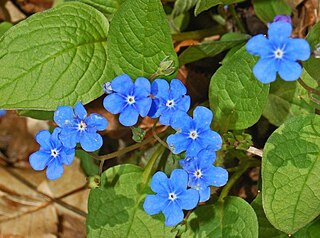
Omphalodes verna, the creeping navelwort or blue-eyed-Mary, is a rhizomatous herbaceous perennial plant in the genus Omphalodes belonging to the family Boraginaceae.

Campanula latifolia, the giant bellflower, is a species of bellflower in the family Campanulaceae. It is also known as the large campanula and the wide-leaved bellflower. It is native to Europe and western Asia and is widely grown as an ornamental plant.

Hemerocallis middendorffii, known as Amur daylily, is a plant species in the subfamily Hemerocallidoideae of the family Asphodelaceae of the order Asparagales. It is native to the Russian Far East, northwest China, Korea, and Japan. It grows in meadows, mountain slopes, open woods, and scrub. It is cultivated in Asia for its edible flowers.
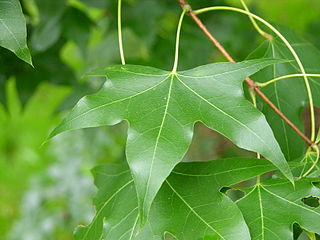
Acer truncatum, the Shantung maple, Shandong maple, or purpleblow maple, is a maple native to northern China, in the provinces of Gansu, Hebei, Henan, Jiangsu, Jilin, Liaoning, Inner Mongolia, Shaanxi, Shandong, Shanxi, and to Korea.

Campanula rapunculoides, known by the common names creeping bellflower, rampion bellflower, rover bellflower, garden bluebell, creeping bluebell, purple bell, garden harebell, and creeping campanula, is a perennial herbaceous plant of the genus Campanula, belonging to the family Campanulaceae. Native to central and southern Europe and west Asia,. in some parts of North America it is an extremely invasive species.

Campanula patula or spreading bellflower is a plant species of the genus Campanula. It can grow to more than half a meter high. This delicate bellflower bears lateral branches of pale blue or white flowers that are upright and funnel shaped. The leaves are narrow and pointed. Branches are often supported by the surrounding vegetation, so the plants can appear prostrate. The main difference between this and other bellflowers is that the petals in the bell are spread out and more pointed and this gives this species its common name.
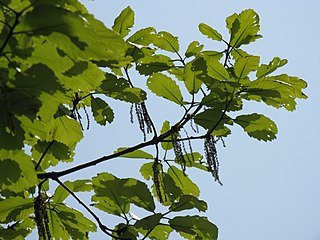
Quercus aliena, the galcham oak or oriental white oak, is a species of oak in the family Fagaceae, in the white oak section Quercus.

Campanula punctata, the spotted bellflower, is a herbaceous perennial flowering plant in the bellflower family. It has leaves and stems which fall down at the end of the blooming season.

Oplismenus undulatifolius, commonly known as wavyleaf basketgrass, is a species of perennial grass from the family Poaceae that is native to Eurasia, specifically Southern Europe through Southern Asia. Due to its invasive nature, it can be found in countries such as Pakistan, China, Japan, Korea, India, Australia, South Africa, and has since been introduced to the Mid-Atlantic United States. There are no recognized subspecies in Catalogue of Life.

Orostachys japonica (Japanese:爪蓮華、昭和、秀女)also known as rock pine is a species of flowering plant in the family Crassulaceae. Native to East Asia. Its main habitat is on the surface of mountain rocks in Korea, Japan and China.
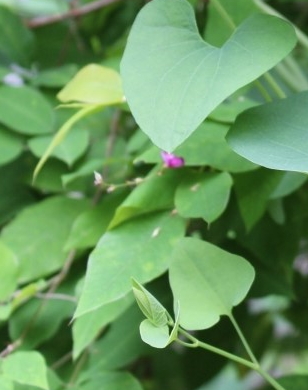
Aristolochia contorta, commonly known as northern pipevine, also known as birthwort, is a climbing perennial shrub.
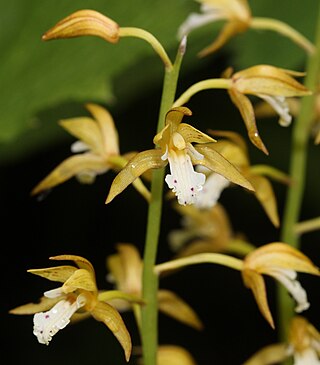
Oreorchis patens, the common oreorchis or 山兰 , is a species of orchid native to eastern Asia. It is known from Japan, Korea, the Russian Far East, and China. The common oreorchis is a terrestrial orchid with a sympodial habit of growth; it flowers on an inflorescence bearing yellow blooms.

Viburnum dilatatum, commonly known as linden arrowwood or linden viburnum, is a deciduous shrub in the moschatel family (Adoxaceae). It is native to eastern Asia, and can be found as an introduced plant in the mid-Atlantic regions in the U.S from New York to Virginia. Linden arrowwood is known for the clusters of red drupes it produces when it is mature.
Cyananthus formusus is a species of perennial flowering plant in the family Campanulaceae. It is native to grassy slopes and forests of northwest Yunnan in China. In Mandarin the species is known as 美丽蓝钟花. Originally described by Ludwig Diels in 1912 in the Notes of the Royal Botanical Garden Edinburgh, the species is a small, blue-flowered plant suitable for Alpine gardens.





















